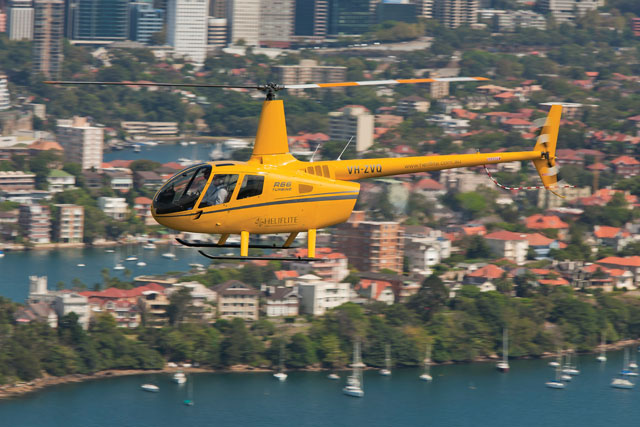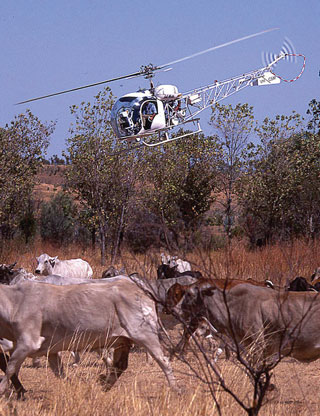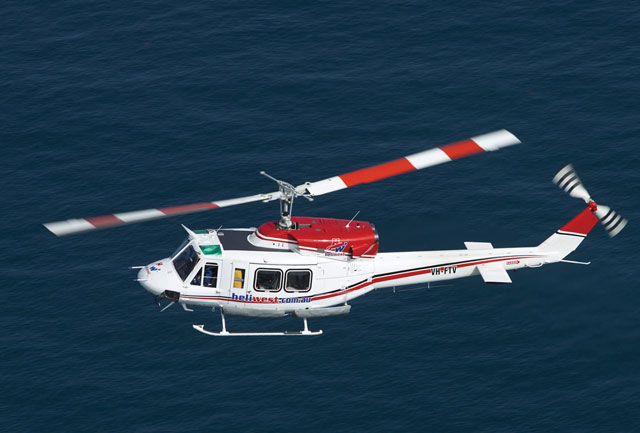Australia's helicopter sector is growing faster than any other in the country's aviation industry, states its Civil Aviation Safety Authority (CASA). It is hardly surprising helicopters are popular in a country surrounded by water, with vast tracts of wilderness, and annual outbreaks of bush fires and floods.
Helicopters are put to work in all areas - including general transportation, firefighting, medical transport, emergency rescue, mustering livestock, offshore oil and gas supply and personnel transportation - even aerial shark patrol.
 |
|---|
| Heliflite Robinson rotorcraft account for more than half of Australia's helicopter fleet |
In late 2012, the 2,000th helicopter was added to the CASA register after a number of years of strong growth - topping 10% on an annual basis. This compares with less than 1% growth for the country's fixed-wing fleet. The helicopter fleet has doubled in the past 10 years - from 980 in 2002 to 1,420 five years later and 2,010 by the middle of December 2012. This growth puts Australia in the sixth position in terms of the number of helicopters - not bad for a country with a population of 22.6 million, says Rob Rich, former president of the defunct Helicopter Association of Australasia (HAA) and local helicopter industry executive who has led the creation of a new representative body, the Australian Helicopter Industry Association (AHIA). The AHIA will be formally launched at the Australian International Airshow, which takes place at Avalon airport in Geelong, Victoria from 26 February to 3 March.
The country's booming resources sector has helped swell the ranks of helicopters in Australia significantly during the past few years, with fleet numbers expected to continue to rise despite warnings of a slowdown in the resources sector. Some 60% of the country's helicopter fleet is located in the resources-rich states of the Northern Territory - Queensland and Western Australia (WA).
This year, HNZ Group - formerly Canadian Helicopters - will put into service three new AgustaWestland AW109SP helicopters on marine transfer flights for resources giant Rio Tinto in WA. HNZ has been providing services to Rio Tinto from its Karratha, WA base since 1992. Under a new 10-year contract which starts in May, the AW109SPs will replace two Eurocopter EC145s which currently serve Rio Tinto's iron ore carriers at Dampier and Cape Lambert ports.
Meanwhile, CHC Helicopters operates more than 30 rotorcraft in Australia in the resources, search and rescue and emergency services sectors. Its biggest contract in the resources sector is a five-year A$300 million ($313 million) deal, with possible contract extensions pushing it to A$500 million, with Woodside Energy which began in June 2011.
The contract was believed to be the largest helicopter service contract ever awarded in the country when it was signed in late 2010. The deal involves a fleet of 19-seat Eurocopter EC225s and 12-15-seat AgustaWestland AW139s based in Karratha, Exmouth and Broome, WA, serving the northwest shelf oil and gas region. CHC recently moved its headquarters from Adelaide in South Australia to Perth, WA, to be closer to its customers in the state's resources sector.
Heliwest, which serves a number of sectors including mining and exploration, geosurvey, pipeline and power line survey, emergency response and equipment transport, is building its Australian resources work following considerable success in the resources industry in Papua New Guinea.
SUPPORT CENTRE
At the end of 2012, Eurocopter established a support centre in Perth specifically to cater for the state's growing fleet. Eurocopter says more than 25 17-19-seat Super Puma-family helicopters are in service in the oil and gas industry in WA's northwest shelf region, in airlift supply and personnel transport operations. Eurocopter expects the fleet to grow significantly during the next three to four years. The centre also supports customers not involved in the resources industry including the WA Police, which has been operating Eurocopter aircraft for more than 25 years, recently putting a new AS365N3+ into service.
But Australia's helicopter sector is by no means all about the resources industry, with about 30 % of the fleet deployed in the agricultural sector, primarily in mustering, states the AHIA. The sector uses light helicopters, mainly Robinson types, and despite the short working year in mustering, the fleet flies more hours annually than the rest of the fleet put together, says Rich.
 |
|---|
| Ned Dawson |
At the same time, expanding search and rescue and helicopter medical services operations are also contributing to the strong growth. Australian Helicopters, for example, operates 18 single- and multi-engined helicopters on emergency medical services, search and rescue, surveillance, civil and border protection and marine pilot transfer services throughout the country.
In fiscal 2011-2012, pistons made up more than 60% of the Australian fleet, with Robinson helicopters accounting for 59% - 531 R22s and 467 R44s. The multi-engined fleet grew 7% during fiscal 2011-2012, with the Bell 412, Kawasaki BK117, Sikorsky S-76, Eurocopter 332 and AgustaWestland 139 topping the list. Of the 2,000-plus helicopters registered, more than 200 are multi-engined types. AHIA expects the multi-engined fleet in particular to experience strong growth on the back of the resources sector, predicting the multi-engined fleet could treble to more than 750 helicopters in the next seven years.
PRESSURE POINTS
Based on current growth rates, Rich says Australia's total helicopter fleet could grow to 3,000 in about six years or 4,000 within 11 years.
Despite its growth, the collapse of the HAA in 2008 left the Australian helicopter sector without a representative industry body. The HAA, formed in 1984, collapsed largely because of a change in its business model, with the association employing salaried staff, and the global financial crisis.
But with the realisation the growing sector needed a body to tackle a number of "pressure points obstructing development", says Rich, the AHIA was set up to tackle skills shortages and training and regulatory issues.
Skills shortages are particularly apparent in instruction and maintenance, says AHIA inaugural president and former Bell Helicopter sales executive Peter Crook. The lack of instructors is set to worsen, particularly with the new Australian army and navy pilot training programme - the Helicopter Aircrew Training System - likely to draw on limited instructor resources. A growing multi-engined fleet is also likely to impact the skills shortages in engineering fields, particularly licensed aircraft maintenance engineers.
The helicopter sector also needs to be part of regulatory changes and the AHIA aims to be the sector's voice and ensure regulations are right for the local industry. "Agencies such as CASA need our help when planning to regulate new technology heading our way," says Rich. He points out there are about half a dozen notices of proposed rulemaking which will impact charter operations, crew rostering, performance standards and helideck standards.
The AHIA aims to promote the local helicopter industry by working with governments, regulatory bodies and the community to ensure it is a safe, efficient and viable industry able to meet the needs of customers by pursuing global best practice, says Rich.
 |
|---|
| Heliwest |
CASA says there have been "notable improvements" in helicopter safety during the past decade, but Australian Transport Safety Bureau statistics show that, while accounting for about 13% of the Australian civil fleet, helicopters were involved in 36% of all general aviation accidents in the past 10 years.
Among the AHIA's objectives are: Promoting safe helicopter operations; establishing an open productive working relationship with CASA; developing an exchange of information among helicopter owners, users, operators, pilots, engineers and support industries; making representations to governments at all levels; establishing an exchange of information with other associations; and promoting new helicopter services to the public.
The association also aims to promote its capabilities to the wider international community, particularly countries in the Asia-Pacific region, where helicopter numbers are increasing.
ROTORTECH CONFERENCE
Participation at the Avalon show will help it achieve this. The AHIA, thanks to sponsorship from Avalon organisers Aerospace Australia, will hold a series of seminars and conferences at the show to promote the local helicopter industry.
The association will also hold a Rotortech 2013 conference at Sydney's Darling Harbour in October, focusing on helicopter marine pilot transfer and offshore resource industry activity, running alongside the Pacific International Maritime Exposition.
"This is a wonderful opportunity to promote ourselves as best we can," says Rich.
Changes in the industry and technology mean the AHIA will have a wider remit than the HAA, which primarily represented helicopter pilots. Rich says: "In the past, this suited the needs of an industry then operating relatively unsophisticated rotorcraft, where logistic and maintenance support requirements were minimal.
"Today, more expensive and technically advanced helicopters are coming into service and the logistical and technical support industry has developed substantially due to the increasing number of civilian and military heavy helicopters."
Source: Flight International























